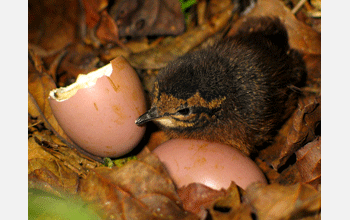Multimedia Gallery
How Many Eggs (Image 3)
Little tinamou (Crypturellus soui) lay just two eggs in a small depression on the forest floor, sometimes lined with a few leaves at the base of a tree or in dense brush. They breed in tropical lowlands, on the edge of rivers and in lowland evergreen forests, as well as secondary forest and lowland shrub lands. [Image 3 of 4 related images. See Image 4.]
More about this Image
A global study, funded by the National Science Foundation and the Christensen Fund, combined data on the clutch sizes (number of eggs laid) of 5,290 species of birds with information on their biology and environment to try and learn why some species lay more eggs than others. This information can be used by researchers to explain a major proportion of the global variation in clutch size and to predict with high confidence, the average clutch size for different types of birds living and breeding in certain environments. For example, cavity nesters such as woodpeckers have larger clutches than open-nesting species, and species in seasonal environments, especially those living at northern latitudes, have larger clutches than tropical birds.
Biologists have found that generally, the species that are short-lived or that have a low survival rate among their offspring tend to lay more eggs at one time to increase the chance of having surviving offspring. In contrast, longer-lived species or those with a higher survival rate among their offspring tend to lay fewer eggs in their nests and invest more time and effort in raising their young. However, the reasons why one species of bird may lay one egg and another 10 are more complex because clutch sizes can vary widely between closely related species due to variations in their environment, nutrition, health and predation.
The authors of the study, Walter Jetz, associate professor of biology at the University of California-San Diego, Cagan Sekercioglu, a senior research scientist at Stanford University, and Katrin Böhning-Gaese of Johannes Gutenberg University in Mainz, Germany, were aided in their investigation by existing detailed records of the life histories of birds throughout the world. Because humanity has been fascinated with birds throughout history, information was also gleaned from historical data collected by thousands of ornithologists and millions of bird enthusiasts, as well as countless books and popular and scientific articles.
"In this study," said Sekercioglu, "We answered one of the most basic questions asked about birds: why do bird species lay different numbers of eggs? The integration of geographic and life history datasets enabled us to simultaneously address the importance of ecological, evolutionary, behavioral and environmental variables in shaping the clutch size of the world's birds. We show that increased environmental variation causes birds to lay larger clutches."
Sekercioglu points out that most ornithological research has taken place in the highly seasonal environments of North America and Europe, but most bird species live in less seasonal tropics. This means that the small clutch size seen in less-studied tropical birds is the norm, not the exception. Increased predation pressure experienced by open-nesting birds also causes them to lay smaller clutches than cavity-nesting birds, literally having fewer eggs in one basket to spread the risk. (Date of Image: unknown)
Credit: Photo by Cagan Sekercioglu
Images and other media in the National Science Foundation Multimedia Gallery are available for use in print and electronic material by NSF employees, members of the media, university staff, teachers and the general public. All media in the gallery are intended for personal, educational and nonprofit/non-commercial use only.
Images credited to the National Science Foundation, a federal agency, are in the public domain. The images were created by employees of the United States Government as part of their official duties or prepared by contractors as "works for hire" for NSF. You may freely use NSF-credited images and, at your discretion, credit NSF with a "Courtesy: National Science Foundation" notation.
Additional information about general usage can be found in Conditions.
Also Available:
Download the high-resolution JPG version of the image. (1.6 MB)
Use your mouse to right-click (Mac users may need to Ctrl-click) the link above and choose the option that will save the file or target to your computer.



